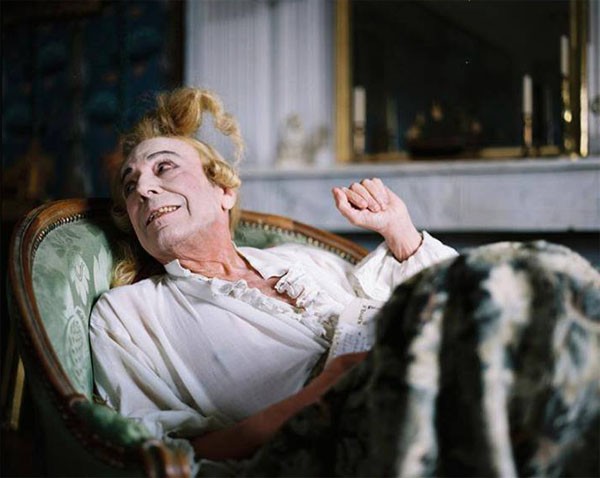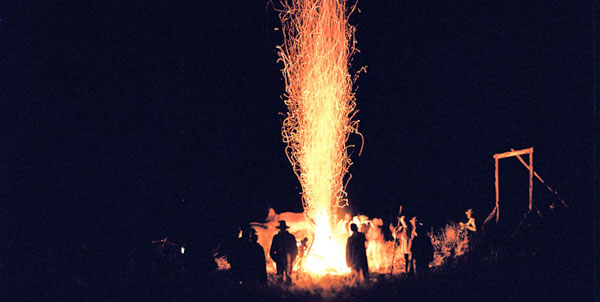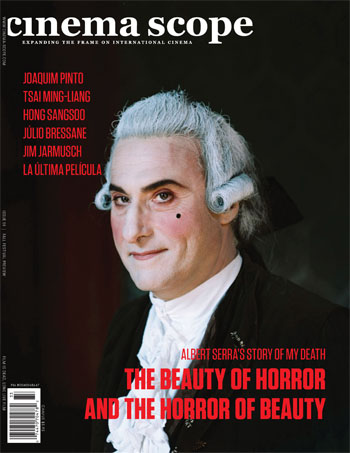Mark Peranson, who’s Head of Programming at Locarno as well as the editor of Cinema Scope, where Alvaro Arroba wrote the entry on Albert Serra in the magazine’s recent “50 Best Filmmakers Under 50” special, and who, it must be added, plays Josef in Serra’s Birdsong (2008), about which Peranson made his own documentary, Waiting for Sancho (2008), has a few very nice things to say about Serra’s Story of My Death. Just because that comes as no surprise, though, doesn’t mean those very nice things ought to be dismissed out of hand. With or without the proverbial grain of salt, I for one will take praise such as this quite seriously:
Working for the first time with some scripted dialogue, and colliding it with his usual method of free improvisation with non-actors, Serra has concocted a truly esoteric and unique work, something contemporary, yet totally free of constraints of time and space. The trappings might be historical and mythical, but his playground is cinematic language; the editing, acting, and photography, all of which are sui generis, contribute to a grand work of art that, as in an alchemic concoction, begins by appearing like waste, but eventually dazzles like solid gold. Bringing to mind filmmakers such as Pasolini, Garrel and Straub, Historia de la meva mort is a constantly surprising film of great beauty, mixing the sacred and the profane, where not a single shot or cut is out of place.
Competing at Locarno, Story of My Death will screen in the Wavelengths program at Toronto, where the program notes tell us that here “Serra imagines an encounter between two other legendary figures of world literature—Casanova and Count Dracula—in this deliciously eccentric and exquisitely detailed riff on the historical costume drama.”
“Unsurprisingly for the director of Birdsong—a black-and-white, digital video depiction of the Three Wise Men that famously includes an eight-minute static shot of nothing but the subjects wandering across an empty desert plane—Serra has made a slow, cryptic work heavy with metaphor and implication but also riddled with details,” writes Indiewire‘s Eric Kohn. “Yet it’s oddly Serra’s most accessible work, the first with scripted dialogue and something closer to a conventional plot. Casanova is a vivid character nevertheless rich with metaphor. Serra’s interpretation is something akin to an anti-biopic that turns the characters into symbols of history in flux.”
Héctor Llanos Martínez interviews Serra for Cineuropa, and it’s a brief but dense conversation. One of the Q’s: “You shot over 400 hours of film. It took you one and a half years to condense those into 150 minutes of film. How did you go about selecting what made the final cut?” Serra: “I gave precedence to scenes filmed inside. During the editing phase, I realized that I preferred them, because I was trying to make the film evoke intimacy and reflection.”
Updates, 8/18: “Albert, congratulations for the Pardo d’oro!” Albert Serra interviews himself at Locarno’s site: “[M]y next project will be smaller, crazier, more radical and less people will watch it!”
For Neil Young, writing for the Hollywood Reporter, Story of My Death to be “a fanciful project that’s tantalizing on paper but largely DOA on screen…. [D]espite moments of cockeyed humor and occasional flashes of genuine inspiration, this 150-minute evocation of 18th century atmospheres is an enervating, embalmed affair. Indeed, in terms of 2013’s more ‘artistic’ treatments of bloodsucker lore, The Story of My Death makes Jim Jarmusch’s stylishy quirky Cannes competitor Only Lovers Left Alive look like Craig Moss’s Twilight parody Breaking Wind.”
Updates, 8/19: Diego Lerer offers his take (in Spanish).
Writing at Cineuropa, Boyd van Hoeij notes that “there’s a conscious effort to coordinate colors and props into tableaux resembling paintings of the period.”
Updates, 8/20: “I was so enthralled by Albert Serra’s Story of My Death that I saw it three times in four days,” writes Michael Pattison at the House Next Door. “Serra’s slow-burn 150-minute romp depicts in enchanting natural light the revolutionary shift from the Enlightenment to irrationalism. Broadly symbolic, the film is also detailed enough that we can see particles of dust move through the air; it’s as if the very atmosphere is charged with transition.”
“No one else working today makes movies remotely like Serra, a cerebral oddball and improbable master of cinematic antiquity,” writes Dennis Lim in the Los Angeles Times. “Against a backdrop of candlelit conversation and barnyard carnality, Serra sets in motion contrasting ideas about pleasure and desire, alternating between winding philosophical dialogue and wordless passages of savage beauty.”
Update, 9/8: “Serra affords Altaió the space to palpably convey Casanova’s voraciousness, whether it’s performing sexual acts, extolling philosophical virtues, downing booze, or seductively chomping on pomegranate seeds,” writes Nick McCarthy at the House Next Door. “This playful opening hour of debauchery, full of Enlightenment-inspired dialogue and signifiers of indulgence, is posited primarily as a rational setup for a trek to the Romantic countryside of darkness—both figuratively and literally. However, this framing device, a sort of red wine-soaked reverie, works better than the sinister narrative it foreshadows—a halting, subjectivity-based hangover that hardly registers before it escapes from the mind.”
Update, 9/12: Danny Kasman in the Notebook: “It is a crepuscular movement from fruit-and-crystal filled interiors of aristocratic opulence to night-cloaked peasant spaces of river crossings, farm houses and a rural landscape that sees the gradual eclipse of the hilarious, snorting-pomp and proselytizing of the Italian’s cultured lifestyle and a waxing thickness of superstitious silences, uneasy sexuality, and ritual slaughters of the later Carpathian countryside. All unfolds, as now seems the welcome norm for Serra, with the same languor and dramatic imprecision which easily fights off any sense of pretension or intellectual game playing despite the long takes and wandering sense of narrative. This is as direct and honest a film as one can imagine, but luminous (in what Casanova dubs the half-light of undergarments) in its muffled, sad-bawdy sensibility. It expresses not just a beautiful historical idea but, in its wispy, pensive thoughtfulness and corporeal presence, a true tone history’s uncanny strangeness.”
Update, 9/17: “With the help of cinematographer Jimmy Gimferrer, Serra captures this clash of Enlightenment and Romanticism in images of consistently awesome beauty that recall still-life portraits of the era,” writes Kenji Fujishima at In Review Online. “Even at its most visually lustrous, though, there is a sense of mournful serenity that lends the film emotional heft even at its most slow-moving.”
Update, 10/30: Patrick Holzapfel talks with Serra for Twitch.
2013 Indexes: Locarno and Toronto. For news and tips throughout the day every day, follow @KeyframeDaily on Twitter and/or the RSS feed. Get Keyframe Daily in your inbox by signing in at fandor.com/daily.






